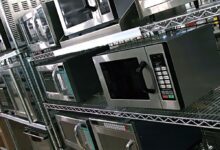Why Do Some Clay Dishes Get Hot in the Microwave

When microwaving, some clay dishes get hot because they retain and transfer heat efficiently due to their composition. Clay dishes absorb microwaves and convert them into heat, causing them to become hot.
Clay dishes are a popular choice for cooking and serving food, as they have excellent heat retention properties. However, when subjected to microwaves, clay dishes can quickly become hot. This is because the clay used in their production absorbs the microwave energy and converts it into heat.
Unlike other materials that may act as insulators, clay efficiently retains and transfers heat. As a result, the clay dish heats up significantly, making it important to use caution when handling it after microwaving. Understanding why some clay dishes get hot in the microwave can help ensure safe and efficient food preparation.

How Microwaves Work
Microwaves work by emitting electromagnetic waves that excite water molecules in food, causing them to vibrate and generate heat. Certain clay dishes heat up in the microwave because the microwaves get absorbed by the clay’s water content, translating into heat energy.
Overview Of Microwave Technology
Microwaves have revolutionized our way of cooking and reheating food, providing us with a convenient and quick method to satisfy our hunger. But have you ever wondered how exactly microwaves work? In this section, we will delve into the fascinating world of microwave technology and uncover the secrets behind this modern kitchen appliance.
Let’s explore the role of microwaves in heating food and understand why some clay dishes can get hot in the microwave.
The Science Behind Microwaves:
Microwave ovens utilize electromagnetic radiation in the microwave frequency range to heat food. Here’s a breakdown of the process:
- Microwaves are a form of non-ionizing radiation, falling between radio waves and infrared radiation on the electromagnetic spectrum.
- The microwave oven contains a magnetron, a device that generates microwaves by converting electrical energy into electromagnetic waves.
- These microwaves pass through the oven’s cavity, which is made of metal, and are then absorbed by the food.
How Microwaves Heat Food:
Microwaves primarily interact with water molecules present in food, causing them to vibrate rapidly. This vibration leads to friction and generates heat within the food. Let’s take a closer look:
- As the microwaves pass through the food, they excite the water molecules, causing them to move vigorously.
- This movement results in the generation of heat, which is then conducted to the surrounding food molecules.
- This process occurs rapidly, allowing a more efficient and uniform heating of the food compared to traditional cooking methods.
The Importance Of Dish Materials:
While most dishes are safe for microwave use, some materials, such as clay dishes, can get hot in the microwave. Here’s why:
- Microwaves penetrate the outer layers of food, heating it from within. This process can cause temperature variations in different areas of the dish.
- Clay dishes, being porous and absorbent, can absorb a significant amount of microwave energy, leading to increased heat retention.
- As a result, clay dishes tend to get hotter than the food itself, potentially causing burns if not handled with caution.
Safety Precautions:
To ensure safe microwave usage, follow these tips:
- Check the manufacturer’s instructions for microwave suitability before using any dishes.
- Avoid using clay dishes in the microwave unless specifically labeled as microwave-safe.
- Use microwave-safe utensils and cover food with microwave-safe lids or wrap to prevent splatters and retain moisture.
- Always use oven mitts or heat-resistant gloves when handling hot dishes to avoid burns.
Understanding the basics of microwave technology can help us make informed decisions when selecting suitable cookware for our microwaves. Whether it’s reheating leftovers or preparing a quick meal, microwaves offer a convenient way to satisfy our hunger. Just remember to choose the right dishes to ensure a safe and enjoyable cooking experience.

Understanding Clay As A Material
Clay dishes can get hot in the microwave because clay is a natural material that retains heat well. When exposed to microwave radiation, the clay absorbs the energy and heats up, which transfers to the food or liquid inside the dish.
Clay dishes can be a great addition to your kitchen, offering a unique cooking experience and enhancing the flavors of your dishes. But have you ever wondered why some clay dishes get hot in the microwave while others don’t? To understand this, let’s delve into the properties of clay, the unique characteristics of clay dishes, and the benefits of using them for cooking.
Properties Of Clay:
- Porous nature: Clay is highly porous, allowing air and moisture to circulate within the material. This property helps in even heat distribution and retention during cooking.
- Excellent heat resistance: Clay is known for its ability to withstand high temperatures without cracking or breaking. This makes it ideal for various cooking methods, including baking, roasting, and even microwave use.
- Natural insulation: Clay has superb insulation properties due to its porosity. It heats up slowly and retains heat for longer periods, helping to cook food evenly and retain moisture.
- Heat retention: Clay dishes have the remarkable ability to retain heat even after being removed from the oven or microwave. This feature keeps your food warm for a longer duration, making it a perfect choice for serving dishes at the table.
The Unique Characteristics Of Clay Dishes:
- Retaining moisture: When clay dishes are heated, the water present in the clay evaporates, creating steam. This steam gradually gets released, ensuring that the food stays moist and tender throughout the cooking process.
- Non-reactive surface: Clay is a natural material and does not react with acidic or alkaline ingredients present in food. This makes it a safe and healthy option for cooking, as there is no transfer of harmful substances to your meals.
- Natural flavors: Clay imparts a subtle earthy flavor to the food, enhancing its taste and aroma. This unique characteristic makes clay dishes particularly popular for preparing traditional and ethnic cuisines.
- Even cooking: The porous nature of clay helps in distributing heat evenly, preventing hotspots and ensuring that your food cooks uniformly. This results in perfectly cooked dishes with delicious flavors.
The Benefits Of Using Clay Dishes For Cooking:
- Healthier cooking: Clay is a natural and non-toxic material, making it a healthier alternative to cookware coated with synthetic materials. It does not release any harmful substances or chemicals into your food, ensuring a safer cooking experience.
- Enhanced flavors: The natural flavors of clay combined with the steam cooking process help in intensifying the taste of your dishes. With clay dishes, you can savor the richness and authenticity of flavors in your favorite recipes.
- Versatility: Clay dishes can be used for a wide range of cooking methods, including baking, grilling, and cooking on stovetops. They are suitable for both traditional and modern recipes, providing you with endless possibilities in the kitchen.
- Aesthetically pleasing: Besides their functional benefits, clay dishes also add a touch of elegance to your dining table. With their rustic appearance and earthy tones, they make for beautiful presentation pieces.
- Sustainability: Clay is a renewable resource that is readily available in nature. Using clay dishes contributes to a greener lifestyle, as they are biodegradable and do not pose any harm to the environment.
Now that you understand the properties of clay, the unique characteristics of clay dishes, and the benefits of using them for cooking, you can explore the world of clay cookware with confidence. Experiment with different recipes and savor the delightful flavors that clay brings to your culinary creations.
Heat Transfer In Microwave Ovens
Clay dishes heat up in the microwave due to a process called heat transfer. When microwaves hit the dish, the clay absorbs the energy and converts it into heat, warming up the dish and its contents.
The Science Behind Heat Transfer In Microwaves:
- Microwaves are a form of electromagnetic radiation that is especially efficient in heating food. When microwaves pass through an object, they cause the water molecules within it to vibrate rapidly, generating heat.
- The heat generated during microwave cooking is the result of a process called dielectric heating. Dielectric heating occurs when polar molecules, such as water, are subjected to an alternating electric field, causing them to align and rotate rapidly. This rapid molecular movement creates friction, and subsequently, heat.
- Microwave ovens emit microwaves with a frequency of around 2.45 gigahertz. This specific frequency allows the microwaves to interact with and heat water molecules efficiently. However, the interaction of microwaves with different materials can vary.
How Microwaves Interact With Different Materials:
- Microwaves interact differently with various materials based on their molecular composition and structure. This interaction determines the level of heat transfer that occurs during microwave cooking.
- Materials that do not contain water molecules, such as ceramics, glass, or some plastics, do not absorb microwaves as effectively as materials with high water content. As a result, these materials can often remain cool in the microwave.
- Conversely, clay dishes contain a significant amount of water molecules bound within their structure. This water content allows clay to absorb and transfer heat effectively in microwave ovens, making clay dishes hot during microwave cooking.
Factors That Affect Heat Transfer In Clay Dishes:
- Water content: The higher the water content in clay, the more efficiently it can absorb and transfer heat in the microwave. Clay dishes with higher water content are more likely to become hot during cooking.
- Clay composition: Different types of clay have varying molecular structures and water-holding capacities, affecting their ability to absorb microwaves. The specific mix of minerals and organic matter in clay can impact its heat absorption properties.
- Thickness and shape: Thicker clay dishes and those with complex shapes may heat less uniformly than thinner and simpler designs. This can result in uneven heating and varying temperature distribution within the dish.
- Microwave power: The power output of the microwave oven also influences heat transfer. Higher power settings can generate more intense microwaves, leading to increased heat transfer in clay dishes.
- Microwave-safe design: Some clay dishes are specifically designed to minimize heat transfer and prevent them from becoming excessively hot in the microwave. These dishes often have added insulation or heat-absorbing layers to protect against excessive heating.
The science behind heat transfer in microwaves involves dielectric heating, where microwaves interact with water molecules in food and other materials. While clay dishes can become hot in the microwave due to their water content and molecular composition, factors like thickness, shape, and microwave power also affect the level of heat transfer.
Manufacturers may employ various strategies to create microwave-safe clay dishes that minimize heat transfer and reduce the risk of overheating.

Why Clay Dishes Get Hot In The Microwave
Clay dishes get hot in the microwave due to their material composition. When microwaves interact with the clay, the water molecules within the dish heat up, causing the dish itself to become hot. This is why it is important to use microwave-safe cookware to prevent potential damage or injury.
The Composition Of Clay Dishes That Makes Them Susceptible To Heating
Clay dishes, which have been used for centuries in cooking and serving meals, possess a unique composition that makes them prone to getting hot in the microwave. Here are some key factors related to the composition of clay dishes that contribute to their heating:
- Porosity: Clay dishes are porous in nature, allowing them to absorb moisture easily. The microscopic pores present in clay act as tiny heat conductors, transferring heat energy effectively.
- Minerals: Clay contains various minerals like quartz, feldspar, mica, and iron oxide, which can enhance heat absorption. These minerals have the ability to vibrate and generate heat when exposed to microwave radiation.
- Lack of glaze: Many clay dishes, such as unglazed terracotta pottery, lack a protective glaze coating. This absence of glaze allows the clay to directly interact with the microwave’s electromagnetic waves, resulting in increased heat production.
- Craftsmanship: The manufacturing process of clay dishes can influence their susceptibility to heating. The thickness, density, and overall quality of the clay used play a crucial role in how well the dish absorbs and retains heat.
The Impact Of Clay’S Moisture Content On Heat Absorption
Moisture content is a significant factor in determining how clay dishes absorb and retain heat. Consider the following points associated with clay’s moisture content and its impact on heat absorption:
- Hygroscopic nature: Clay has the ability to absorb moisture from its surroundings. When exposed to the moisture present in food, the clay dish absorbs it, contributing to heat absorption. The higher the moisture content of the clay, the more heat it can generate.
- Moisture loss: As the clay dish heats up, any moisture it contains will gradually evaporate. This process further contributes to the heating of the dish, as the loss of moisture leads to an increase in temperature.
- Uneven moisture distribution: The clay’s moisture content may not be evenly distributed throughout the dish. This unevenness can result in certain areas heating up more quickly than others, creating hotspots.
- Rehydratation effect: Subsequent reheating and cooling cycles can cause the clay dish to absorb and release moisture repeatedly. This rehydratation effect can amplify the dish’s ability to absorb and retain heat.
How Clay Dishes Retain And Distribute Heat
Clay dishes possess unique properties that aid in both the retention and distribution of heat. Here are a few points explaining these characteristics:
- Thermal conductivity: Clay is known for its relatively high thermal conductivity, which allows it to absorb and hold heat efficiently. This property ensures that the dish remains hot even after removing it from the microwave.
- Heat retention: Clay’s ability to retain heat is influenced by its composition and density. The density of the clay dish allows it to store and slowly release heat, keeping food warm for longer periods.
- Heat distribution: Clay evenly distributes heat throughout its structure due to its thermal conductivity. This distribution fosters uniform cooking and heating, minimizing the occurrence of cold spots in the dish.
- Cooking benefits: Clay dishes’ heat retention and distribution properties make them excellent for slow cooking methods. By utilizing the retained heat, clay dishes can cook food evenly and infuse it with rich flavors.
The composition of clay dishes, their moisture content, and their ability to retain and distribute heat contribute to their tendency to get hot in the microwave. Understanding these factors can help us appreciate the unique qualities of clay dishes and utilize them effectively in our cooking routines.
The Importance Of Preheating Clay Dishes
To ensure safe and efficient microwave usage of clay dishes, preheating is vital. The heat generated inside the microwave causes certain clay dishes to become hot, making preheating necessary to prevent cracking and improve overall dish performance.
Preheating As A Common Practice In Cooking With Clay Dishes
Cooking with clay dishes can be a delightful experience. There’s just something about the earthy and rustic charm of clay that adds a unique touch to our culinary adventures. However, if you’ve ever used a clay dish in the microwave, you may have noticed that some dishes tend to get hot while others remain cool.
This intriguing phenomenon is caused by the way clay interacts with microwave radiation. We will dive deeper into the importance of preheating clay dishes and explore the benefits and techniques of this common practice.
The Benefits And Purposes Of Preheating
Preheating clay dishes serves several purposes that enhance the cooking process and overall experience. Here are the key benefits of preheating:
- Enhanced heat distribution: Preheating clay dishes allows them to absorb and distribute heat more evenly. This ensures that your food cooks uniformly, avoiding hot and cold spots.
- Improved cooking efficiency: By preheating the dish before cooking, you optimize its ability to retain heat. This can significantly reduce cooking times, saving you precious minutes in the kitchen.
- Enhanced flavors: When the clay dish is properly preheated, it creates a unique atmosphere for cooking. This environment helps flavors to mingle and develop, resulting in more delicious and aromatic dishes.
Preheating Techniques For Clay Dishes In The Microwave
Preheating clay dishes in the microwave requires a careful approach to avoid damage or accidents. Here are some techniques you can follow:
- Wet towel method: Moisten a clean kitchen towel, fold it in half, and place it under the clay dish in the microwave. This technique helps distribute heat more evenly and prevents overheating.
- Gradual heating: Instead of placing the clay dish directly into the microwave, start by heating it at a lower power setting for 1-2 minutes. Gradually increase the power until reaching the desired temperature. This gradual heating process helps prevent sudden temperature changes.
- Preheating in intervals: If you’re worried about overheating, you can try preheating the clay dish in short intervals, allowing it to cool slightly between each interval. This method minimizes the risk of overheating while still achieving the desired preheating effect.
Remember, the exact preheating technique may vary depending on the type and thickness of the clay dish, so it’s essential to refer to the manufacturer’s instructions for specific guidance.
Preheating clay dishes before using them in the microwave is a valuable practice that can significantly enhance your cooking experience. By ensuring even heat distribution, improving cooking efficiency, and enhancing flavors, preheating allows you to unlock the true potential of cooking with clay.
So, the next time you reach for your favorite clay dish, take a moment to preheat it and enjoy the wonderful results it brings to your culinary creations.
Potential Risks And Precautions
Clay dishes can get hot in the microwave due to their composition, which absorbs and retains heat. To prevent potential risks, it is important to use microwave-safe clay dishes and follow precautions such as ensuring they are not cracked or damaged, using microwave-safe covers, and monitoring the temperature during heating.
The Possibility Of Overheating Clay Dishes In The Microwave:
- Microwaving clay dishes can cause them to become hot and potentially pose a risk of burning or melting.
- The main reason behind this is that clay is a natural material and can contain moisture, which when exposed to microwave radiation, can heat up rapidly.
- During the heating process, the moisture in the clay can turn into steam, causing the dish to become hot and ultimately leading to potential damage or even breakage.
- The high temperature can also affect the glaze or finish on the clay dish, causing it to crack or melt.
Tips For Avoiding Overheating And Preventing Damage:
- Before using clay dishes in the microwave, it’s essential to check whether they are labeled as microwave-safe. If not, it is safer to avoid microwaving them altogether.
- Use ceramic or glass dishes specifically designed for microwave use if you need to heat or cook food in the microwave.
- If you do decide to use clay dishes in the microwave, take some precautions to prevent overheating:
- Moisten a paper towel or cloth and place it underneath the clay dish. This can help distribute the heat more evenly and reduce the risk of overheating.
- Use lower power settings or short microwaving intervals, allowing the dish time to cool down in between.
- Stir or rotate the dish during microwaving to promote even heating and prevent hot spots.
- Avoid microwaving clay dishes that have any cracks, chips, or loose glaze, as they are more prone to overheating and potential breakage.
- After microwaving, be cautious when handling clay dishes, as they can remain hot. Use oven mitts or pot holders to avoid burns.

Proper Handling And Care For Clay Dishes:
- When it comes to handling clay dishes, being gentle is key. Here are some tips to ensure their longevity:
- Avoid sudden temperature changes. For example, do not transfer a hot clay dish directly from the microwave to a cold surface or immerse it in cold water immediately after use.
- Allow clay dishes to cool naturally before washing or placing in the dishwasher to prevent cracks or breakage.
- Clean clay dishes by hand using mild dish soap and a soft sponge or cloth. Avoid abrasive scrubbers or harsh chemicals that can damage the clay or glaze.
- Store clay dishes in a dry and cool place to prevent moisture absorption, which can weaken the clay and potentially lead to cracking or breakage.
- Regularly inspect clay dishes for any damage, including cracks, chips, or loose glaze. If you notice any issues, it’s best to discontinue use to avoid possible risks.
By following these precautions and caring for your clay dishes properly, you can enjoy their beauty and functionality while ensuring your safety in the microwave.
Alternatives To Clay Dishes In The Microwave
Clay dishes can get hot in the microwave due to their porous nature. However, there are alternatives available such as microwave-safe glass or ceramic dishes that distribute heat more evenly and do not retain heat as much.
Microwaving food is a convenient and time-saving way to prepare meals, but not all dishes are suitable for microwave use. Clay dishes, although popular for their beautiful and rustic appeal, can often get extremely hot when microwaved. If you’re concerned about the safety and functionality of clay dishes in your microwave, don’t fret! There are other microwave-safe alternatives available that will give you the same delicious results without the risk of overheating or damage.
Exploring Other Microwave-Safe Materials
When it comes to finding alternative microwave-safe materials, consider the following options:
- Glass: Glass dishes are versatile, heat-resistant, and microwave-safe. They distribute heat evenly and are perfect for reheating leftovers or cooking various dishes.
- Ceramic: Ceramic dishes, like porcelain or stoneware, are excellent choices for microwave use. They are durable, microwave-safe, and can handle high temperatures without getting excessively hot.
- Microwave-safe plastics: Some plastic containers are specifically designed for microwave use. Look for containers labeled as microwave-safe to ensure they can withstand the heat without melting or releasing harmful chemicals.
Comparing The Pros And Cons Of Different Microwave-Safe Dishes
Each alternative material has its own set of advantages and considerations, as outlined below:
- Glass:
- Pros: Distributes heat evenly, transparent for easy monitoring, dishwasher-safe, and comes in various sizes and shapes.
- Cons: Fragile and can break when dropped or subjected to sudden temperature changes.
- Ceramic:
- Pros: Microwave-safe, maintains heat well, durable, and perfect for oven-to-table serving.
- Cons: Can be heavy, may retain heat for longer, and certain types may have reactive glazes that could affect food taste or safety.
- Microwave-safe plastics:
- Pros: Lightweight, affordable, available in different sizes and shapes, and generally dishwasher-safe.
- Cons: Prone to staining, may warp over time, and can potentially release harmful chemicals if not labeled as microwave-safe.
Choosing The Right Cookware For Specific Dishes Or Recipes
It is crucial to select the appropriate cookware for your specific dishes or recipes to ensure optimal results and safety. Consider the following guidelines:
- Glass: Ideal for heating or reheating dishes that require even distribution of heat, such as soups, casseroles, or saucy dishes.
- Ceramic: Perfect for recipes that involve baking or any dishes that go from oven to table, like baked pasta or gratins.
- Microwave-safe plastics: Suitable for meals that require quick heating or steaming, such as vegetables, rice, or leftovers.
Remember to always check the manufacturer’s guidelines for each specific dish or container before using them in the microwave to ensure their safety and compatibility. By exploring alternative microwave-safe materials, comparing their pros and cons, and selecting the right cookware for your specific needs, you can enjoy hassle-free microwave cooking without the risk of overheating or damaging your dishes.

Frequently Asked Questions On Why Do Some Clay Dishes Get Hot In The Microwave
Why Do Some Clay Dishes Get Hot In The Microwave?
Clay dishes get hot in the microwave because the clay absorbs microwave energy and converts it into heat. This heat is then transferred to the food, resulting in hot dishes. Clay’s porous nature and ability to retain heat make it a great conductor, but it’s important to use caution when handling hot clay dishes.
Are All Clay Dishes Safe For Microwave Use?
Not all clay dishes are safe for microwave use. While some clay dishes are microwave-safe, others may contain metallic elements or glazes that can cause sparks or excessive heating. To ensure safety, always check the manufacturer’s instructions or look for the microwave-safe symbol on the bottom of the dish before using it.
How Can I Avoid Clay Dishes Getting Too Hot In The Microwave?
To avoid clay dishes getting too hot in the microwave, use lower power settings and shorter cooking times. Additionally, placing a microwave-safe cover or lid on the dish can help distribute heat evenly and prevent overheating. It’s essential to monitor the dish while microwaving and use oven mitts or towels to handle hot dishes safely.
Can Clay Dishes Crack In The Microwave?
Yes, clay dishes can crack in the microwave if they are not microwave-safe or if exposed to rapid temperature changes. Avoid placing frozen or cold dishes directly into the microwave, as this can cause thermal shock and lead to cracks.
It’s best to gradually warm up clay dishes and avoid sudden temperature extremes.
Conclusion
It is important to understand why some clay dishes get hot in the microwave. The high heat conductivity of clay allows it to quickly absorb and distribute heat, resulting in hot spots in the dish. Microwaves work by emitting electromagnetic waves that excite water molecules, generating heat.
While clay dishes do not contain water, they can still absorb the energy from the microwaves and heat up. The composition and thickness of the clay also play a role in how hot the dish gets. To prevent overheating or potential damage to your clay dishes, it is best to use microwave-safe alternatives like glass or ceramic.
Additionally, always check the manufacturer’s instructions to ensure that your dishes are microwave safe. By understanding the science behind clay dishes and microwaves, you can make informed decisions and ensure the safety of your cookware.










